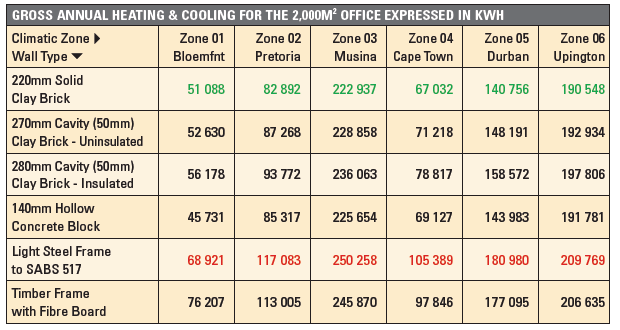Shouldn't Affordable Housing be affordable for life?
Clay brick has a long track record of providing sustainable, thermally comfortable and cost effective infrastructure buildings with an assured low lifecycle cost. As the industry standard with SABS approval, clay brick comes up against numerous new products that present themselves as equal, or even better.
Dr Llewellyn van Wyk, Principal Researcher at CSIR Built Environment Division endorses ABTs ("Alternative" pre-fabricated concrete panels) as more efficient than clay brick wall construction for school buildings. He supports his case by highlighting that some "32 Agrement certificated IBTs identified for use in the construction of schools perform better than conventional building".
Mr John Barnard director of SASFA emphasises the benefits of Light Steel Frame Building (LSFB). "as wide ranging compared with conventional building methods in terms of quality, cost, durability and speed".
The suppliers of one of the new pre-fabricated walling systems promote themselves as "the only innovative building technology that compares with double brick plastered in terms of structure, fire, acoustic attenuation and thermal properties".
Are these claims valid?
A review of the Physical Characteristics pamphlet and the Agrement certificates 2010/376 and 2011/400 pertaining to the highest certificated IBT wall panel system shows the following comparison with 220 mm double brick solid walls:
Strength: Relative Strength Factor
- ABT 50mm Panel - 3.8
- ABT 75mm Panel- 3.8
- 220mm standard solid Masonry Wall - 5.8
Fire Rating: Comparative Fire Ratings
- ABT 50mm Panel - 1 Hour
- ABT 75mm Panel - 2 Hours
- 220mm standard Solid Clay Brick - 4 Hours
So in reality, the 220mm solid clay brick wall values are almost double those of the leading, certified ABT wall panel system (and the majority of ABT's are not certified or SABS approved in any way).
Energy savings claims
Thanks to a decade of empirical research and analysis of real buildings under real world conditions at the University of Newcastle, Priority Research Centre for Energy, various parametric studies, and no less than five thermal modelling studies of different building typologies comprising different wall construction types, the clay brick industry has substantive evidence confirming that wall construction types that include clay brick will outperform LSF specified SANS 517 walled buildings in South African climates. The thermal mass inherent in clay bricks is what brings the 'X' factor to the thermal efficiency equation.

As depicted in Table 1, when it comes to office/institutional type buildings solid 220mm double skin clay brick walls (R0.45) and 270mm clay brick cavity walls (R0.65) provide requisite thermal mass and resistance to outperform SANS 204 compliant lightweight walling (R 1.9 and R2.2) in terms of day-time thermal efficiency.
The University of Pretoria study produced some key findings that included:
- "Solid clay brick masonry is the most thermally and energy efficient walling system considered for day-time or non residential occupancy buildings, (or for Climatic Zone 4, a 270mm clay brick cavity wall)"
- "The most efficient South African walling system for residential buildings is a 280mm insulated cavity brick masonary wall':
- "Clay brick masonry cavity walls are generally the more thermally and energy efficient walling system for all day or residential occupancy buildings':
- "Light steel frame wall construction presently specified models in SANS 517 is not thermally efficient and uses more heating and cooling energy compared to clay brick masonry cavity walls in all climatic regions",
- There is a significant energy cost (20-JOO/o) associated with the use of lightweight partitioning systems in all 3 building typologies modelled.
This latter finding, correlates with that of the empirical research at the University of Newcastle, where clay brick internal partition walls enhanced energy efficiency of buildings no matter the external walling construction type. The study found that clay brick partition walls enhanced the thermal performance of the insulated lightweight walled building by 20%.
Please see the attached Technical Brochure for detailed information




